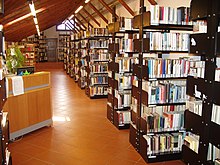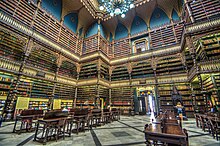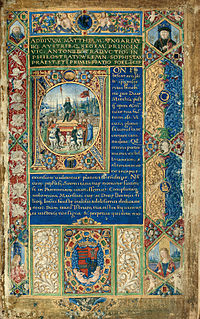Library
A library can be defined, from a strictly etymological point of view, as the place where books are kept. However, at present this conception has been surpassed to refer to both bibliographic and audiovisual collections as well as the institutions that create them and put them into service to meet the needs of users. Since October 24, 1997, that day has been celebrated as International Library Day.
Etymology
The word library comes from the Latin bibliothēca, which in turn derives from the Greek βιβλιοθήκη (bibliothēke), which is composed of βιβλίον ('biblíon', 'book') and θήκη ('théke', 'cupboard, box'); that is to say, it referred to the place where the books were kept. Initially, these books were papyrus scrolls, as it was the most common book format at the time. In the Greco-Latin world it was called codex.
Definitions
According to the UNE 50113-1:1992 standard on basic concepts of information and documentation, the term library can be defined in two ways:
- Any organized collection of printed books and serial publications or other types of graphic or audiovisual documents available for loan or consultation.
- Agency, or part of it, whose main function is to build libraries, maintain, update and facilitate the use of documents that users need to meet their information, research, educational or leisure needs, with a specialized staff.
According to the ALA (American Library Association) a library is defined as a “Collection of information material organized so that it can be accessed by a group of users. It has personnel in charge of services and programs related to the information needs of readers.”
The ISO 2789-1991 standard (UNE-EN ISO 2789 Standard) on international library statistics defines it as: "Organization or part of it whose main function is to maintain a collection and facilitate, through staff services, the use of the documents necessary to satisfy the information, research, educational and leisure needs of its readers.”
Manuel Carrión defines it in his Library Manual as "A collection of books properly organized for its use." It must be clarified that Carrión takes the term book in a broad sense as a synonym for a document, that is, as an information support intended to be read, and which contains a part of social knowledge. This last precision excludes archival documents, which have been generated by a natural or legal person in the exercise of their functions and do not belong to social knowledge.
In all definitions we distinguish three fundamental elements: collection, organization and use. These three elements are accompanied by a fourth factor, the personnel in charge of its management and who is a key part of the whole.
When we talk about collection, we refer to a heterogeneous and constantly evolving reality. For many centuries it was limited to books, initially handwritten, then printed. Subsequently, periodicals and other forms were incorporated. Then cartographic material, printed music, graphic elements, audiovisuals, microfiches, etc. In a next step, the electronic files were incorporated into physical supports stored in the library, and today, thanks to the development of telecommunications and the Internet, libraries begin to have access to documents that they will never physically possess, since they are stored on remote servers. sometimes on other continents. This has given rise to the emergence of the concept of digital library.
Following Professor García Gutiérrez, the organization refers to the application of a set of standardized techniques (documentary analysis), based on scientific knowledge, to a set of documents in order to make it more controllable and usable in its subsequent recovery.
The use is identified with the satisfaction of the needs of the users, that is, obtaining the document or the information requested.
Of the three elements mentioned, modern Library Science places special emphasis on use, that is, on users, because it is the raison d'être of libraries, since the other two factors, the collection and its organization, exist depending on the satisfaction of their information needs. In this sense, we observe how, through time, the focus of attention has progressively shifted from the collection and its conservation, to its organization and then to its use.
The person in charge of carrying out these procedures is the Librarian, who organizes the library's material, assisting all types of users in their demand for information. Since its inception, librarians have been changing their role, they have gone from being simple book custodians to professionals trained to organize library documents in any format.
In 1931 the great Indian librarian Ranganathan formulated his five laws, which perfectly summarize the spirit of modern Library Science:
- The books are to be used.
- To every reader his book.
- To each book his reader.
- You have to save the reader time.
- The library is a growing organism.
History
Libraries are a consolidated reality throughout more than four thousand years of history, which runs parallel to that of writing and books.
Antiquity
Originally they had a nature more typical of what today is considered an archive than a library. They were born in the temples of the Mesopotamian cities, where they initially had a conservative function, recording events linked to religious, political, economic and administrative activity, at the service of a caste of scribes and priests. The documents were written in cuneiform on clay tablets, a coarse and heavy support, but one that has guaranteed their preservation. The libraries-archives of Mari, Lagash and Ebla, as well as that of the Assyrian king Ashurbanipal, were especially noteworthy.
In Ancient Egypt there were two kinds of institutions: Houses of Books, which served as archives for administrative documentation, and Houses of Life, which were study centers for scribes and which possessed collections of which copies could be made. Writing, in its various forms, hieroglyphic, hieratic, or demotic, was collected on papyrus scrolls.
In ancient Greece, books and libraries reached a great development. The libraries adopted forms that can be considered as antecedents of the current ones. Greek writing, derived from Semitic aliphate, made it possible to somewhat generalize access to reading and books and for the first time libraries to appear unrelated to temples. The Hellenistic period was the birth of great legendary libraries, such as the Library of Alexandria or the Library of Pergamon, which were created with the purpose of gathering all the social knowledge of their time and making it available to scholars.
In Rome, indebted to Greek culture, the same scripture support was used, the papyrus roll. The first public library of which there is evidence was founded there, by Asinio Pollio, and there were great libraries, such as the Octaviana and Palatina, created by Augustus, and the Ulpia Library, of the Emperor Trajan. Roman libraries used to have a Greek and a Roman section.
With the rise of Christianity, a new format began to spread, the parchment codex, and reading began to shift from pagan institutions, in frank decline, to those of the nascent Christian Church.
Middle Ages
In medieval times, with the invasions of the barbarians and the fall of the Western Roman Empire, culture receded and took refuge in monasteries and cathedral desks, the only places that house libraries worthy of the name. They are centers where Christian culture and the remains of the classical culture are kept, at the service of Religion. Libraries of monasteries, such as Saint Gall, Fulda, Reichenau, Monte Casino in Europe or Santo Domingo de Silos, San Millán de la Cogolla, Sahagún or Santa María de Ripoll in Spain, became the centers of knowledge of their time.
Starting in the Late Middle Ages, with the creation of universities first and with the invention and diffusion of the printing press, new university libraries were created, while books reached new sectors of the population. The General Study of Salamanca, antecedent of its University, was the first to have a library for use by students from the date of its creation (1218).
In the East, Byzantium acted as a link with classical culture, which survived in this way, influencing the Arab and Slavic world and also backward Western Europe. Here there were large libraries in monasteries and cities. The Arab world also created its libraries linked to the mosques and the Koranic teaching centers, madrasas. Some of the largest libraries of the time were also created here, such as that of Caliph Al-Mamum in Baghdad or Abd-al-Rahman III and that of his son Al-Hakam II in Córdoba.
In the late Middle Ages, during the Renaissance, King Matthias Corvinus of Hungary (1458-1490) patronized painters, poets, musicians, scientists, and all kinds of intellectuals from all over Europe. In the 1460s, he founded in his palace in the city of Buda the Bibliotheca Corvinniana , which had more than 3000 books, being considered the largest of its time after the Library from the Vatican. Although the library was destroyed after the Turkish invasion of 1526, many of the volumes survived and are now in the world's leading museums.
Modern Age
The Renaissance marked by the invention of the printing press, the creation of Johannes Gutenberg, and the struggles derived from the Protestant Reformation, saw the emergence, thanks to humanist ideals, of a new model of princely library. This current will lead to the appearance of royal libraries and high nobility, which thanks to the new values are open to a public of scholars and scholars. The French XVI century or those created in Austria and Bavaria stand out in the XVI century. In Spain, those of Hernando de Colón, that of the Complutense University and that of El Escorial, created by Felipe II, model of the later Baroque libraries, stand out.
In the 17th century great scholarly libraries were founded, such as the Bodleian in Oxford, the Ambrosian in Milan or the Mazarin in Paris, where Gabriel Naudé was the librarian, author of Advis pour dresser una bibliothequè, considered the Father of Library Science (also known as Library Science).
During the 18th century the British Museum Library, predecessor of today's British Library, and the Royal Library were created, germ of the National Library of Spain. The Braidense Library, in Milan, and the Real de Lisboa were born in this century. Also dating from this period are those that would be, over time, the university libraries of Yale, Harvard and Princeton.
Contemporary Age
The French and American revolutions promoted the spread throughout Europe and America of new democratic principles and the birth of a true desire to make culture and education accessible to all. In the world of libraries, this meant the birth of a disentailment fever that spread throughout the continent and transferred to society an immense bibliographic treasure from the institutions of the Old Regime, particularly the Catholic Church. Despite everything, this desire to bring culture closer to the whole of society did not come true until the middle of the XIX century, with the appearance in the Anglo-Saxon world of the public library (public library).
Gradually the idea that all human beings have the right to free access to information was consolidated. However, following Carrión, it can be affirmed that in view of this fact, three currents were established that have determined the librarian thought of the XX century:
- The continental European conception, strongly marked by the weight of the ancient funds and with a great conservative and bibliophilic vocation, which sees the research libraries as the authentic libraries. It assists the public library with an educational mission.
- The Anglo-Saxon conception, very influenced by ideas such as free access to information, the desire to achieve its maximum diffusion, a very active inter-biblio-technical cooperation and the library extension.
- The socialist conception, which sees in the library an essential instrument in education but also of propaganda and ideological control of society.
With the fall of the Berlin Wall in 1989, the socialist model entered into crisis and today it has practically disappeared, with a few exceptions, trying to adapt to the new democratic values and continuous budget cuts. The Anglo-Saxon model has spread throughout the world during the second half of the XX century and has strongly influenced current Library Science, especially thanks to the doctrines of IFLA and UNESCO, with programs such as UAP (Universal Availability of Publications), UBC (Universal Bibliographic Control), PAC (Preservation and Conservation) or UDT (Universal Dataflow and Telecommunications). The continental conception still survives, exerting a great influence on the national libraries and in the background on many research and superior libraries. It has also influenced by contributing its educational nature to the library.
At the end of the XX century, digital libraries appeared. With the development of digital readers, "electronic" and with them digital and electronic libraries.
Library typology
Libraries can be classified according to various criteria (users, access, geographic scope, etc.). The most used classifications are those proposed by Unesco and IFLA (International Federation of Library Associations and Libraries):
UNESCO Classification
- National libraries
- The so-called “national banks” represent the head of the state system. They are funded by public funds and meet a dual purpose: to provide bibliographical research material for any discipline, and to preserve and disseminate the cultural heritage (referring to information recorded over time) of each country. In general, each State has a library that is considered “national” and whose objectives are the ones described above. Just cite some paradigmatic cases, serve as examples the United States Library of Congress, the British Library, the Spanish National Library, the National Library of France, the National Library of Argentina, the National Library of Mexico, the National Library of Chile, the National Library of Colombia and the National Library of Venezuela.
- University libraries
- These are the libraries of the faculties, schools and other academic units of universities and higher education centres. They differ from research libraries. They are at the service of their students and have to support the educational and research programmes of the institutions in which they are integrated, of which they generally obtain their funding.
- Other major non-specialized libraries
- Scientific and scholarly, neither university nor national. For example: Regional libraries.
- School libraries
- They complement the programmes of the institutions to which they belong, although they also have non-formal books to encourage the habit of reading. Many have different audiovisual and electronic media. Its funding comes from the schools in which they are integrated. The school library provides learning services, books and other resources, to all members of the school community to develop critical thinking and effectively use information in any support and format. School libraries are interrelated with the wide network of libraries and information according to the principles of the UNESCO Manifesto on the public library.
- Specialized libraries
- Specialized libraries are designed to meet specific professional needs. For this reason, they often depend on specific companies, companies, organizations and institutions, which provide their employees and customers with these services during their work. The training of staff in a specialized library includes both knowledge of the subject matter that covers its funds and of bibliotheconomy. In Alcobendas, within the Pedro Ferrándiz Foundation, there is the Samaranch library where the world's largest library is located on basketball themes.
- Public libraries
- Public libraries aim to respond to the wide range of needs that their users can demand. In addition to classical literary works, their funds may be composed of texts that provide information on social services, reference works, discs, films and recreational books. Many of them sponsor and organize complementary cultural events, such as conferences, debates, theatrical performances, musical concerts, film screenings and artistic exhibitions. In this regard, children ' s services should be mentioned, a characteristic section of public libraries that promotes literary sessions, seeks the existence of a small children ' s library and sometimes even has units with toys. Since the aim of public libraries is to meet the needs of as many as possible citizens, they also often have reading and hearing machines, as well as books printed in special formats (e.g. Braille) for people with vision problems. The funding of these libraries comes from the local public authorities.
Some of the new formulas for children's libraries are the library bus and the bebetecas. The bookmobile is a mobile library that travels periodically through different neighborhoods of the city, offering library services to children, young people and adults. Its objective is to facilitate access to information, culture and free time for all citizens, especially those who, because they live in small or scattered towns, lack a stable library. The bebetecas are defined as a special care service for young children (from 0 to 6 years old) that includes, in addition to a space and a collection of books chosen to meet the needs of the youngest and their parents, the loan of these books, regular talks about their use and stories, advice and constant attention from library professionals to users.
Classification
- Division I: General Research Libraries
- National libraries.
- University libraries and other general research libraries.
- Libraries and information services for parliamentarians.
- Division II: Specialized libraries.
- Government libraries.
- Social Science Library.
- Geography and Maps libraries.
- Libraries of Science and Technology.
- Biomedical and Health Science Libraries.
- Art libraries.
- Libraries of Genealogy and Local History
- Division III: Libraries that cater to the public.
- Public libraries.
- Libraries for the disabled.
- Libraries for children and adolescents.
- School libraries and resource centres.
- Libraries for the blind.
- Librarian services for multicultural populations.
- Metropolitan libraries.
- Mobile libraries.
Quotes
The bibliothèque est le lieu de l'exercice public de la raison.The library is the place of the public exercise of reason.Gabriel Naudé in Advis pour dresser une bibliothèque
Contenido relacionado
60's
Princess of Asturias Award for International Cooperation
Frequent questions













